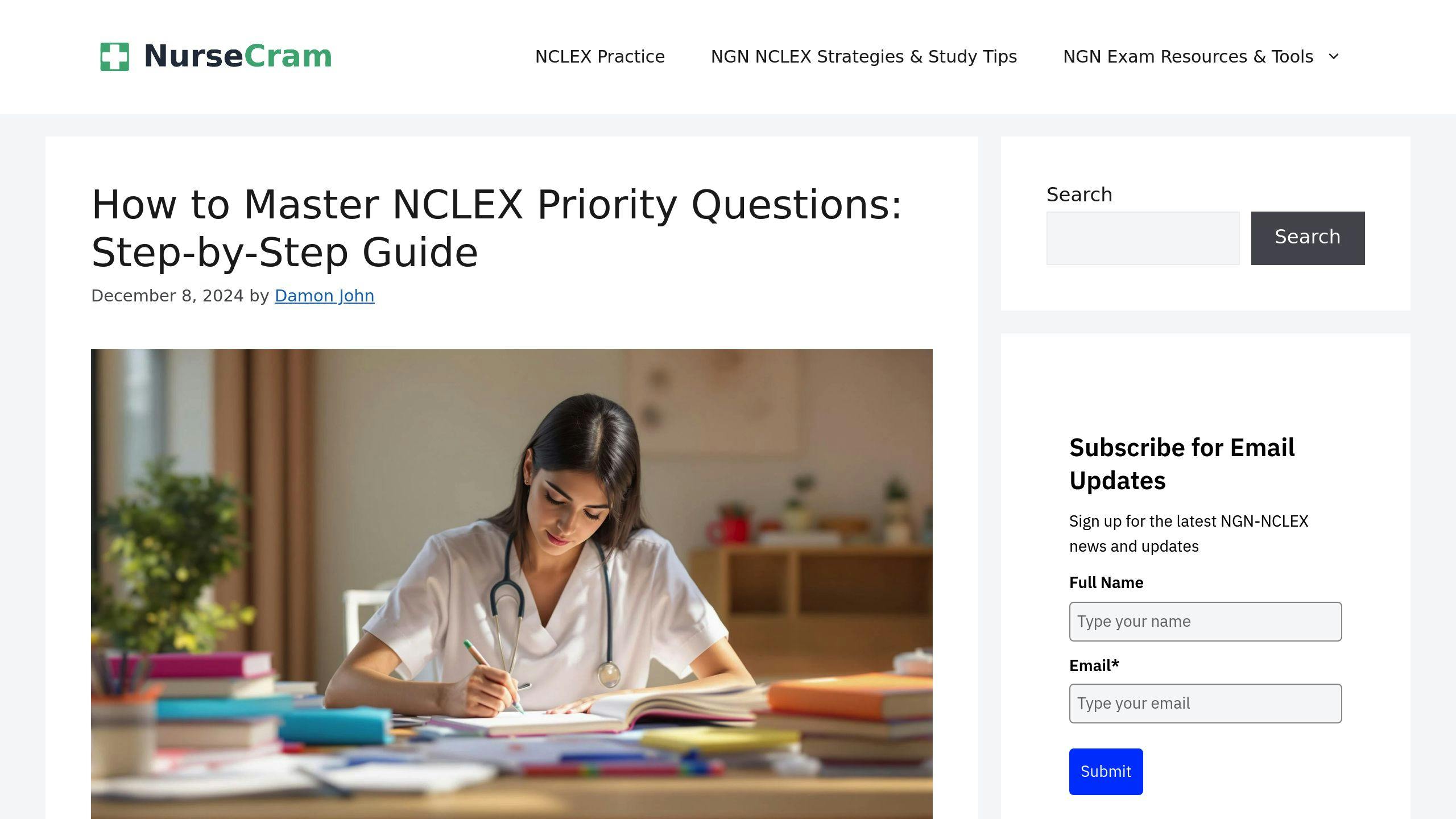Want to ace the NGN exam? Focus on multisystem practice questions. These questions test your ability to connect knowledge across body systems, a critical skill for real-world nursing. Here’s what you need to know:
- Exam Overview: 70-145 scored questions + 15 unscored pretest items, using adaptive testing and new formats like case studies and drag-and-drop.
- Why Multisystem Practice Matters: Reflects real-life complexities, requiring you to manage conditions like diabetes while considering cardiovascular, kidney, and neurological impacts.
- Question Formats: Includes matrix/grid, cloze, drag-and-drop, and extended multiple-choice. Partial credit is awarded for logical reasoning.
- Top Study Tips:
- Practice case studies step-by-step.
- Use resources like NurseCram, Kaplan, Nurseslabs, and UWorld.
- Focus on time management and clinical judgment.
Quick Tip: Master the NCJMM’s six clinical judgment steps – recognize cues, analyze data, prioritize, generate solutions, act, and evaluate outcomes – to boost your exam performance. Now, let’s dive deeper into how to excel at these questions.
Features of NGN Multisystem Questions
How Multisystem Scenarios Work
The NGN exam uses a split-screen setup that mimics real-life electronic health records (EHRs). On one side, you’ll see the client’s record with tabs for key patient details like history, vitals, labs, medications, and assessments. The other side displays the questions you need to answer [1].
Each scenario is designed to reflect the complexities of real patient care. This format lets you refer to clinical data while answering questions, much like using healthcare documentation systems in practice [1].
Getting familiar with how patient data is organized is crucial for handling the NGN’s various question types, each aimed at testing specific areas of clinical judgment.
Types of NGN Question Formats
The NGN exam uses several question formats to evaluate clinical decision-making skills [2]:
| Question Format | Description and Purpose |
|---|---|
| Matrix/Grid | Matches symptoms with interventions across different systems. |
| Cloze | Focuses on identifying specific values and parameters in a given context. |
| Drag-and-Drop | Tests prioritization skills, like arranging interventions for conditions like COPD and kidney disease. |
| Extended Multiple-Choice | Examines understanding across multiple systems in a single question. |
The exam uses polytomous scoring, meaning you can earn partial credit based on the clinical reasoning shown in your answers [3]. This scoring approach acknowledges logical judgment, even when there are multiple valid solutions.
To succeed, you’ll need to evaluate how actions in one system might impact others. Mastering these formats allows you to handle complex scenarios smoothly, a key ability for NGN performance [1].
Tips for Solving NGN Multisystem Questions
Building Critical Thinking and Clinical Judgment
The NCJMM outlines six steps of clinical judgment, which are essential for tackling multisystem cases. These steps include recognizing key symptoms across different systems and identifying the most urgent issues [1].
| Clinical Judgment Function | Application in Multisystem Cases |
|---|---|
| Recognizing Cues | Spot symptoms across multiple systems |
| Analyzing Cues | Link symptoms between systems |
| Prioritizing Hypotheses | Identify the most critical system concerns |
| Generating Solutions | Develop interventions for all affected systems |
| Taking Action | Deliver care while monitoring multiple factors |
| Evaluating Outcomes | Check patient responses across systems |
This structured process enhances your ability to think critically and approach NGN questions with confidence.
Study Methods That Work
Preparing for the NGN requires practice with case studies that involve multiple systems. These cases mimic the complexity of the exam, helping you build the skills you need [2].
Here are some effective strategies:
- Work through case studies step-by-step, explaining your thought process.
- Look for patterns that connect related conditions.
- Use timed exercises to simulate multisystem scenarios.
For additional support, NurseCram’s NCLEX Exam Review provides scenario-based exercises with detailed explanations, helping you refine your reasoning skills [3].
Managing Time on Complex Questions
Time management is key when handling the NGN’s challenging multisystem questions [2]. Use this approach:
- Quickly identify the systems involved in the scenario.
- Focus on the most relevant EHR details.
- Tackle each part of the question methodically.
Since the exam uses polytomous scoring (partial credit), always demonstrate your reasoning, even if you’re unsure of the complete answer [3]. This approach can help maximize your score.
Best Resources for NGN Multisystem Practice
Nurse Cram NCLEX Exam Review

NurseCram is a dedicated platform tailored for tackling the Next Generation NCLEX’s multisystem questions. It offers tools that align closely with the NGN’s clinical judgment testing model [1]:
| Feature | Description |
|---|---|
| Practice Questions & Scenarios | Covers all NGN formats with complex, multisystem cases |
| Readiness Exams | Full-length simulations mirroring the NGN format and timing |
| Clinical Judgment Guidance | Step-by-step guidance with detailed explanations |
Each answer choice on NurseCram is paired with a detailed rationale, helping students grasp not only the correct answer but also the reasoning behind clinical decisions [3]. While NurseCram is an excellent starting point, adding other resources to your study routine can further strengthen your preparation.
Other Useful Study Tools
In addition to NurseCram, there are other tools that can help you prepare for the NGN:
| Resource | Key Benefits | Focus Areas |
|---|---|---|
| Kaplan Quizzes | Free NGN-format practice | Case studies, single-item questions |
| Nurseslabs | Updated 2024 question bank | Clinical judgment scenarios |
| UWorld | Exercises to build clinical reasoning | Multisystem integration |
Recent NGN exam data highlights the inclusion of three unfolding case studies, each with six items, totaling 18 questions focused on multisystem knowledge [1][3]. Kaplan’s free quizzes, Nurseslabs’ updated questions, and UWorld’s clinical reasoning exercises provide varied approaches to these scenarios. Using a mix of these resources ensures a broad understanding of multisystem integration, a critical component of NGN success.
Combining tools like NurseCram with these additional resources can give you diverse insights into clinical situations, helping you build confidence and expertise for the exam [3][4].
sbb-itb-aa73634
Next Gen NCLEX NGN Question Types: Multiple Response Select N & Matrix Questions
Conclusion: Preparing for NGN Multisystem Questions
The NGN exam pushes test-takers with new formats designed to evaluate clinical judgment and the ability to connect knowledge across various body systems. To excel, focus on understanding the clinical judgment model, practicing strategically, and managing your time effectively [1].
How to Excel on the NGN Exam
Success on the NGN hinges on three main areas:
Building Clinical Judgment Skills
The clinical judgment model plays a major role in your performance. The exam includes 70-145 scored questions, many of which involve case studies that require you to combine knowledge from different systems [1].
Practicing with Strategy
The NGN uses a partial credit system, rewarding logical thinking. Here’s a breakdown of key scoring types and how to approach them:
| Scoring Type | What It Involves | Best Approach |
|---|---|---|
| Plus/Minus | Multiple-choice | Assess each option closely |
| Zero/One | Single-answer questions | Choose the most accurate |
| All or Nothing | Case studies | Thoroughly analyze details |
Mastering Time Management
With Computerized Adaptive Testing (CAT), staying on pace is essential. Timed practice sessions can help you build the endurance needed to handle the exam’s complex scenarios [3].
Leverage resources like NurseCram and consistently work through multisystem scenarios to sharpen your skills. By focusing on clinical judgment, strategic practice, and time management, you’ll be well-prepared to face the NGN and advance in your nursing career [1][3].
FAQs
How to answer case study questions in NCLEX?
Tackling NGN case studies requires a clear, step-by-step approach based on the clinical judgment model. Here’s a breakdown to help you manage these questions effectively:
| Step | Action | Focus Area |
|---|---|---|
| Recognize Cues | Carefully review the client record | Spot key symptoms across systems to prioritize accurately |
| Analyze Cues | Link symptoms to possible conditions | Connect details across different body systems |
| Prioritize Hypotheses | Focus on the most likely scenarios | Address the most urgent clinical concerns |
Understanding the Format
NGN case studies feature a split-screen layout. One side displays the client record, while the other includes various question types like matrix or drag-and-drop, mimicking real-world documentation systems [1].
Scoring System
The NGN uses partial credit scoring. For instance, you can earn points for partially correct answers, such as matching symptoms with interventions in matrix questions or selecting some correct options in multiple-response formats [1].
Time Management Tips
Make the most of your time by:
- Scanning the case quickly.
- Focusing on critical client data.
- Systematically eliminating wrong options.
Since case studies account for 21% of the total score [4], balancing speed and accuracy in your clinical judgment is crucial.
Practicing different question formats and understanding how the scoring works will build your confidence. A systematic method lets you tackle even the toughest NGN scenarios with ease.
Related posts
- How to Analyze NGN NCLEX Scenario Questions
- NGN NCLEX Scenario Exercises: Step-by-Step Practice
- Top 7 Clinical Cues to Watch for in NGN Scenarios
- NGN Case Studies for Multisystem Knowledge

Mia is dedicated to helping nursing students and new graduates confidently prepare for the Next Generation NCLEX exam. With a focus on providing clear, actionable advice and support, Mia offers practical study tips, effective strategies, and encouragement to guide you through the complexities of nursing exams. Whether you need help mastering question formats, managing stress, or creating a personalized study plan, Mia is here to ensure you feel prepared and empowered every step of the way.

